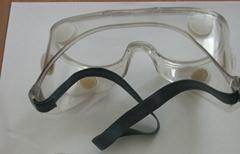- today
- label Guide
- favorite 0 likes
Eye and face protection
Some workplaces, especially in such industries as, for example, mining, energy, construction, forestry, pose a risk to the eyes and face. The eye's natural protection, i.e. the conjunctiva, protects it from contamination and infection (by creating a thin layer of slightly oily tear fluid). However, it may not be sufficient. In such cases, it is necessary to use eye protection measures. They should be used where there are risks:
- strokes,
- optical radiation,
- dusts and gases,
- liquid drops and splashes,
- molten metals and hot solids,
- electric arc.
There are four categories of eye protection measures to protect against these factors:
- goggles,
- protective goggles,
- face shields,
- welding shields (this category of eye protection includes welding shields: shields, helmets, goggles and hoods).
In the categories of eye protection listed, visors, protective glasses, nets or filters are installed (the group of filters includes: welding filters, ultraviolet protection filters, infrared protection filters, sun protection filters, laser radiation protection filters). All eye protection categories consist of a transparent part (visors, lenses, nets or filters) and a frame (for glasses and goggles) or a body with headgear (for shields).
Safety glasses - this is the most commonly used eye protection. They can be equipped with covers that protect against the entry of hazardous liquid splashes or splashes of solids from the front and side.
Safety goggles (Fig. 5) meet higher requirements, especially in terms of tightness. The construction of the protective goggles ensures a tight fit to the user's face. As a result, they can also be used for protection against biological factors. Protective glasses and goggles, due to their small surface and good adhesion to the user's body, should not allow excessive accumulation of electrostatic charge, and thus pose a high risk of explosion in explosive atmospheres.

Fig. 5. Protective goggles
Face shields are designed to protect the entire face. Their large protective surface minimizes the likelihood of penetrating hazardous liquid splashes. Due to the relatively large surface of the covers and the possibility of isolating them from the user's body with fastening elements, there is a significant risk of accumulating an excessive amount of electrostatic charges.
Welding shields are the basic category of eye protection. They provide protection for the user against harmful optical radiation and other specific types of hazards, e.g. during welding.
A protective lens is a common element for most of the eye protection categories described above. Its primary task is to protect against impacts. It is made of polymethyl methacrylate, cellulose acetate and (mostly) polycarbonate with a thickness of 0.25 mm to 3 mm. This material is characterized by very high mechanical strength. The disadvantage of polycarbonate, mainly due to its electrostatic properties, such as: high resistance, limited possibilities of discharging the accumulated charge (fixing method), easy introduction of charges to the surface (rubbing), is the risk of causing hazards in zones where there is an explosive atmosphere. It is also common (especially for goggles) to apply layers that will prevent scratching, UV and / or IR radiation. All applied coatings can have a significant impact (positive and negative) on the electrostatic properties of eye and face protection.
